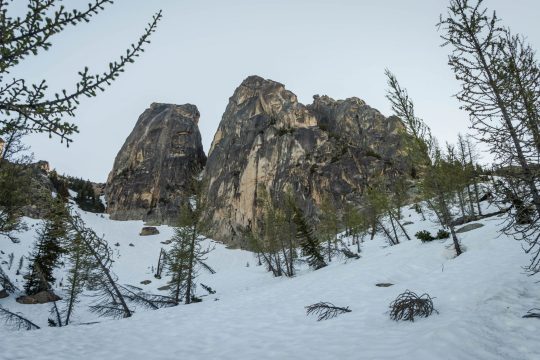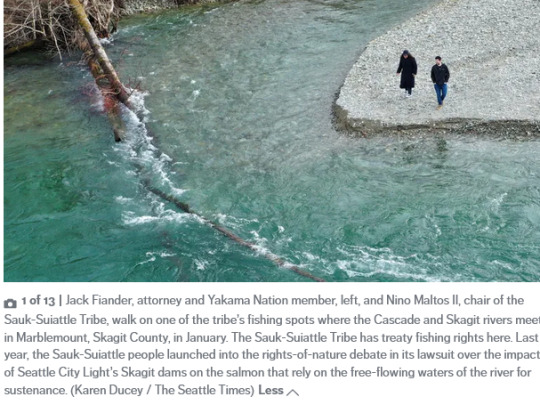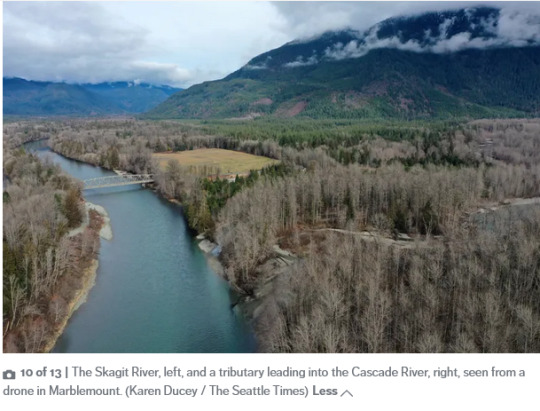#South Washington Cascades
Video
My Travel Paintings - Washington Pass Okanogan-Wenatchee National Forest by Mark Stevens
Via Flickr:
Peaks, Spires and a Ridgeline Covered with Snow. On the original image I posted here on Flickr (www.flickr.com/photos/14723335@N05/38672370244/in/album-7...), I commented on standing at Washington Pass Overlook while in the Okanogan-Wenatchee National Forest and savoring the views and cool temperatures...and loving it! But it was an uncertain stop that I have to thank the friend I was with for wanting to go further on Washington State Route 20 in the North Cascades mountains. To think I might have missed taking in views of these rugged mountains...lucky me! As for the digital painting, I continued to practice more in using broader paint brush strokes like I'd seen in a Bob Ross video and watching another painter friend of mine. General highlights I worked on was with a Kyle acrylic brush. I like the digital effect it created as it seemingly had texture to it and not the smoothed over look other brushes have. I could then decrease the brush size for more precision in other area. I used more of Kyle’s Rakes - Zen Grind brush for the trees going up the mountainside. Work that I wouldn't call my favorite one but good enough to convey some changes in color and hue to create a sense of relief across the mountain. Could I have spent more time and added more detailed view of trees? Yes, but I was attempting to paint a quicker style and not spend weeks like I had in the past. What I did like was using a blend in colors as it produced a much better look than the typical Normal blend. The last area that really took a while to get the right look was with the clouds. In my mind, I knew the brush stroke I wanted but couldn't get that look on the digital canvas. I decided on using a Kyle's Dry Media -Compressed Charcoal and then adjusting the blend mode produced the closest result. What I found worked best was to brush out the brighter white area. I could then darken the hue, adding a shade feel to a portion of the clouds next to that brighter white area. I would blend at the edges. I would repeat that with an even darker area next to that. I would repeat all that again in another portion of the clouds. There's still some work to do, but I like the result more with feel of clouds. The last area was my continuing work with blue skies and adding a watercolor brush on top to break up and not have that smooth sky look. In the left foreground of the painting, you'll find that stick figure image of me "hiking" with my Cubbies hat, loving my time exploring the North Cascade mountains of Washington :-)
#Azimuth 181#Blue Lake Peak#Blue Skies#Blues Skies with Clouds#Cascade Range#Concord Tower#Cornice Peak#Curve in Highway#Curve in Road#Day 8#Drive to Washington Pass Overlook#Early Winter Spire#Early Winter Spires#Evergreen Trees#Evergreens#Hillside of Trees#Landscape#Lexington Tower#Liberty Bell Mountain#Looking South#Methow Mountains#Mountain Peak#Mountains#Mountains in Distance#Mountains off in Distance#Mountainside#Nature#North Cascades#North Cascades National Park Service Complex#Okanogan National Forest
2 notes
·
View notes
Text
South Early Winters Spire Southwest Couloir + Blue Lake Peak / 南早冬尖塔
South Early Winters Spire Southwest Couloir + Blue Lake Peak / 南早冬尖塔
South Early Winters Spire southwest couloir makes the most popular early-season snow climb. Sitting above Washington Pass, the peak is also the highest point of the Liberty Bell. Its nearest taller neighbor sits over on Copper Benchmark.
One step closer to South Early Winters Spire
See more trip photos here.
South Early Winters Spire at a Glance
Access: Blue Lake TrailheadRound Trip: 4…

View On WordPress
#Cascade Loop Scenic Highway#Cascades#early winters spires#Fourth of July#Highway 20#liberty bell mountain#mountaineering#rock climbing#south early winters spire#Washington Pass
0 notes
Text





For the third year in a row, she’s the MVP — Mom, Very Proud — of Mount Rainier’s wolverine population. Joni the wolverine made headlines in 2020 after rearing two male kits, making her the first wolverine mom at the park in more than 100 years. [...] She had another two kits in 2021 — a boy and a girl — starting a streak of successful parenting. And this summer, researchers snapped photos of Joni bounding across the snow with yet another new pair of little ones. [...] It’s not very common for wolverines to rear kits three years in a row, said Dr. Jocelyn Akins, researcher and founder of the Cascades Carnivore Project. [...] The resident male of Mt. Rainier, Van cruises a huge territory that reaches almost up to Snoqualmie pass [...]. Wolverines are fierce scavengers and hunters that claim vast territories [...]. They once roamed as far south as California, but due largely to human activity, wolverines had disappeared from Washington by the early to mid-20th century. Their recovery since then has been slow. Wolverines in Washington have for decades been mostly confined to the North Cascades, north of Highway 90. [...]
---
Headline, images, captions, and text above published by: Alex Bruell. “Joni the wolverine does it again.” Enumclaw Courier-Herald. 21 December 2022. [Bold emphasis added by me.]
Older press release headlines from US NPS:

The distribution range of wolverine in North America [map by Environment Canada]:

And the region:

481 notes
·
View notes
Text
Perhaps one way to describe Cascade red foxes is sensitive.

Vulpes vulpes cascadensis, as our Cascade red foxes are known scientifically, are a native species found only in the higher elevations of the Cascade Mountains in Washington state. They are small, topping out about 15 pounds. They are colorful with fur ranging from red to tan to silver to black.

While being fluffy and furry does help with staying warm during the wintery seasons on the mountain, the Cascade fox isn’t sleeping through winter. They are out and about looking for food. Ok, looking is not always the right verb. Listening for food. Smelling for prey. There are some animals awake through the winter living under the snow. Animals like voles that make tunnels under the snow. By listening, as well as smelling and using all their sense, foxes can locate prey animals under the snow. Snowshoe hares and pocket gophers are also common prey so Cascade red foxes are willing to use all their senses to bring down any small animal for a winter-time snack.

These little carnivores are wonderfully matched to the snowy environments they inhabit. They do not need any food from humans. Feeding wildlife is dangerous to humans, who might be harmed by food-conditioned animals. Feeding wildlife is also dangerous to animals. They are not adapted to eating human food and get too close to humans. Some of these precious animals have even been run over by cars while begging for food. Learn more about helping wildlife at Keeping Wildlife Wild.
More information on Cascade red foxes in the national park can be found here https://www.nps.gov/mora/learn/nature/carnivores.htm
These photographs are from years past and do not reflect current conditions. NPS/S. Redman Photo. Tan and black Cascade red fox in the Paradise area. July, 2010. NPS Photo. Two Cascade red foxes in tac and black walking on snow in the Stevens Canyon area. NPS Photo. Black and silver Cascade red fox walking on brown grass past rock and trees in area south of Paradise. April, 2005.
#keep wildlife wild#encuentra tu parque#find your park#national parks#winter#cascade red fox#wildlife
345 notes
·
View notes
Photo

Washington State's South Cascades Elevation Map
by u/acomfysweater
Hi, I got the data using the USGS's earth explorer. I extracted a SRTM tile at 1-arcsecond resolution (3601x3601 pixels) in a latitude/longitude projection (EPSG:4326). It was reprojected into EPSG Projection 2286 - NAD83 / Washington South (ftUS). I utilized John Nelson's method to hillshading, as well as this terrain tooletset: https://www.esri.com/arcgis-blog/products/3d-gis/3d-gis/terrain-tools-1-1-released
I used ArcGIS Pro to make the map.
129 notes
·
View notes
Text

Sunset at Proposal Rock, Neskowin Beach, Or. / Feb 2022
One of my favorite hikes to do on the Oregon coast is Cascade Head. The views from there are spectacular. The only thing I don't like about it is there's no beach time on the trail. So I almost always drive up to Neskowin Beach after finishing that hike to walk the beach. And if you are lucky, and you never know with Oregon weather, you might just catch a gorgeous sunset.
One of these days I am going to hike to the top of Proposal Rock. The tides though have never been in my favor. The Neskowin Ghost Forest is also here. Just a little south of Proposal Rock. It's the remnants of a Sitka Spruce Forest that were left after an earthquake from the Cascadia subduction zone.
And if you think California is going to have the big earthquake someday. Read up on the Cascadia Subduction zone. It's going to be devastating to Oregon and Washington state. And on that note, I hope everyone has a blessed weekend.
22 notes
·
View notes
Text
I saw this back when I used to use Reddit (for animal crossing and trans+ stuff mostly), and I felt so honoured that they used my Florida flag redesign in this that I screenshotted it. But when I looked to find the original poster, they had deleted the post (likely because of negative replies, vexillology Reddit is scary).

They recreated the state flags to be more about symbolism and individuality rather than about aesthetics (which is the problem I see with a lot of over simplified state flags). All while keeping the flags that actually carry deep meaning and are beloved by the residents.
I’m not the biggest fan of Nebraska’s, Virginia’s, and Wisconsin’s, but all the others are wonderful (especially Florida’s… I will not apologize for being biased lol)
The original Reddit person’s caption:
“I kept some flags which I believe are currently great. Most of them are all over State merchandise, and people of these states carry a lot of state pride for these flags. They are:
1. Alabama
2. Alaska
3. Arizona
4. Arkansas
5. California
6. Colorado
7. lowa
8. Maryland
9. Mississippi
10. Missouri
11. New Mexico
12. Ohio, my home state! [not mine, OPs]
13. Rhode Island
14. South Carolina
15. Tennessee
16. Texas
17. Utah
18. Wyoming
19. District of Columbia [I believe you mean the Douglass Commonwealth]
20. Guam
21. The Northern Mariana Islands
22. Puerto Rico
I've switched some State’s boring Seal on a Bedsheet flags into their more popular historical ones. They are:
23. Conecticut ~ New England Flag
24. Hawaii ~ Kanaka Maoli
25. Maine ~ Original State Flag
26. Vermont ~ Green Mountain Boys Flag
27. Virginia ~ Gadsden Flag
28. West Virginia ~ Original State Flag
I've made a few tweaks to some existing flags so they look more unique / are more easily recognizable. They are:
29. Indiana ~ Golden Frame
30. New Jersey ~ Added Stripes
31. North Carolina ~ Un-Tex-ified
32. Oklahoma ~ Added Stripes
33. American Samoa ~ Added Southern Cross
I designed some using the Pan Cascade colours for the Pacific Northwest (BC will have the tree one). They are:
34. Idaho
35. Oregon
36. Washington
I borrowed some other designs which I found on here which I found beautiful. I mostly looked for flags which were designed by locals from the states that they are redesigning or included state symbols on their old flags. They are:
37. Florida [omg they chose mine!!!]
38. Georgia
39. Kansas
40. Kentucky
41. Louisiana
42. Michigan
43. Montana
44. Nevada
45. New Hampshire
46. New York
47. North Dakota [I prefer my communist flag better wajajaja]
48. Pennsylvania
49. South Dakota
50. Wisconsin
51. Virgin Islands
I left the flags currently in the process of a redesign blank, for, given the recent track record, any new flags are probably going to look amazing like Utah’s and Mississippi’s. They are:
52. Illinois [this is your reminder to vote for your new state flag if you’re from this state!!!]
53. Massachusetts [this is your reminder to vote for your new state flag if you’re from this state!!!]
54. Minnesota [this is your reminder to vote for your new state flag if you’re from this state!!!]
I kept one Seal on a Bedsheet flag to honour this horrid time in American vexillological history. That is:
55. Delaware
And lastly
56. Nebraska (idk)”
While I agree with most of the OP’s opinions, I think Nebraska’s flag would look better if it looked something like this:

Better designed of course, I made this on Pic Collage in like 5 minutes
Im not sure about Wisconsin and Virginia, I just know I’m not the biggest fan of either (since Virginia’s flag has a separate meaning and Wisconsin’s is just bland.
Let me know what you think!
And if you’re the OP of this, please let me know, I like your choices!!
#usa#united states#state flags#alabama#alaska#arizona#arkansas#california#colorado#conecticut#delaware#florida#georgia#hawaii#idaho#illinois#indiana#iowa#kansas#kentucky#lousiana#maine#maryland#massachusetts#michigan#minnesota#mississippi#missouri#montana#nebraska
17 notes
·
View notes
Text

Foundry Workers Melt Down Charlottesville’s Robert E. Lee Statue
Eventually, an artist will be chosen to transform the bronze bars into a public art installation
The controversial bronze statue of Confederate General Robert E. Lee that stood for nearly a century in Charlottesville, Virginia, has been melted down so that it may someday be transformed into a public art installation.
On Saturday, at a foundry in an undisclosed location in the American South, workers cut the infamous figure into small pieces, then fed those pieces into a 2,250-degree furnace. They poured the metal into molds for ingots, or rectangular bars, imprinted with the words “Swords Into Plowshares.” That’s the name of the project that will transform the divisive monument into a new piece of public art.

Only a small group of people, including a handful of journalists, was allowed to watch the melting. They were invited on the condition that they didn’t disclose the name or location of the foundry—or the identities of its workers—over fears of retaliation.
“The risk is being targeted by people of hate, having my business damaged, having threats to family and friends,” says the foundry’s owner, a Black man, to the Washington Post’s Teo Armus and Hadley Green.
Even so, the man added, “When you are approached with such an honor, especially to destroy hate, you have to do it.”

One particularly poignant moment occurred when foundry workers removed the statue’s face from the rest of the head.
“A man in heat-resistant attire pulled down his gold-plated visor, turned on his plasma torch and sliced into the face of Robert E. Lee,” writes Erin Thompson, an art historian at the John Jay College of Criminal Justice and author of Smashing Statues: The Rise and Fall of America’s Public Monuments, in a guest essay for the New York Times. “The hollow bronze head glowed green and purple as the flame burned through layers of patina and wax. Drops of molten red metal cascaded to the ground.”
The 21-foot-tall statue’s journey to this point was a long and complicated one. Commissioned in 1917 and installed in 1924, it loomed over a downtown Charlottesville park for decades.
In 2017, amid a broader national debate over Confederate monuments, white supremacists gathered in Charlottesville to protest the statue’s removal. During the “Unite the Right” rally, a man drove his car into a group of counter-protesters, killing 32-year-old Heather Heyer and injuring many others.
After years of legal battles, the statue finally came down in July 2021. The city donated it to the Jefferson School African American Heritage Center, which has been responsible for it ever since and leads the Swords Into Plowshares project.


Organizers had wanted to melt down the statue sooner, but they waited until a judge dismissed a lawsuit against the plan.
Because of the statue’s size, the melting process will take weeks. Once that work is finished, project organizers will move on to the next phase of their plan: choosing an artist who will transform the metal into something new.
“Humpty Dumpty couldn’t be put back together again,” said Reverend Isaac Collins, a Methodist minister in Charlottesville who spoke at the melting ceremony, per NPR’s Debbie Elliott. “We still have a lot of work to do, but this statue that has cost us so much, so much violence, so much hurt, so much bloodshed—it’s gone. And it’s never going to be put back together the way it was.”
By Sarah Kuta.
#Foundry Workers Melt Down Charlottesville’s Robert E. Lee Statue#robert e lee#Henry Shrady#Leo Lentelli#Walter Blair#unite the right#confederacy#hate#racism#sculpture#bronze sculpture#art#artist#art work#art world#art news
13 notes
·
View notes
Text
Frog Lake to Barlow Pass on the PCT
As hikers walk north from Warm Spring Reservation heading toward Mt. Hood, they pass Timothy Lake and Little Crater Lake before crossing Warm Springs Highway and reaching Frog Lake, with its popular campground and day use area. One of the smoothest sections of the PCT trail in Oregon is between Frog Lake and Barlow Pass trailheads. The trail is fairly wide and almost always in great condition, making it a fast run. The Frog Lake to Barlow Pass distance is just 5 miles.

Old wooden trail sign at Twin Lakes – PCT trail junction.
Not far north of Frog Lake, the PCT passes Twin Lakes, lakes fed from nearby springs providing crystal clear waters that in the right light provide reflections from Mt. Hood to the north.

Mt. Hood from Upper Twin Lake.

Mt. Hood and Balsamroot at Palmateer Point
Barlow Pass and the famous Barlow Wagon Road, another emigrant route built in 1846, passes not far to the south of Mt. Hood. Its construction allowed covered wagons to cross the Cascade Range and reach the Willamette Valley, which had previously been nearly impossible. Even so, it was by far the most harrowing 100 miles of the nearly 2,000-mile Oregon Trail.
The Pacific Crest Trailside Reader: Oregon and Washington includes a story about the Barlow Road. There are many parallels between the Naches Pass Road mentioned in the previous post and the Barlow Road.

Dinner at Little Crater Lake Campground, 1991
"It was a wonderful swim at Timothy Lake and enjoyable evening at Little Crater Lake which is a 45-foot deep artesian spring . . . absolutely crystal clear and 40 degrees. We are camping in a 'self service' campground with a few people camped here also. It seems a little strange to have cars driving around and other people camped nearby, but it is made up for by having a PICNIC TABLE to sit at, and water from a pump to drink." July 29, 1991 (Jim Peacock)
The next day we walked 16 miles stopping for lunch at Frog Lake, continuing the "unremarkable". I walked in tennis shoes to give a 'hot spot' on my little toe some relief. We continued pass Barlow Pass another three miles positioned for our exit the next morning at Timberline Lodge.
4 notes
·
View notes
Photo

Rob Rogers
* * * *
LETTERS FROM AN AMERICAN
April 16, 2023
HEATHER COX RICHARDSON
APR 17, 2023
A few quick notes tonight about some ongoing stories:
There is more news about Supreme Court Justice Clarence Thomas and his misreporting of his financial connections. This morning, Shawn Boburg and Emma Brown of the Washington Post reported that for twenty years, Thomas has reported rental income totaling hundreds of thousands of dollars from a real estate firm that was shut down in 2006.
The misstatement might be dismissed as a problem with paperwork, the authors note. “But it is among a series of errors and omissions that Thomas has made on required annual financial disclosure forms over the past several decades, a review of those records shows. Together, they have raised questions about how seriously Thomas views his responsibility to accurately report details about his finances to the public.”
The cascade of stories about Thomas threatens to continue to undermine the legitimacy of this Supreme Court.
Last night, the nation suffered one mass shooting in Dadeville, Alabama, that killed four people and wounded twenty-eight others, and another in Louisville, Kentucky, that killed two and wounded four. On Friday, Republican hopefuls for the 2024 presidential nomination courted members of the National Rifle Association, the NRA, at the organization’s 2023 annual convention, promising looser gun laws.
South Dakota governor Kristi Noem complained about liberals who “want to take our guns,” and boasted that her granddaughter, who is not yet two, has a shotgun and a rifle.
Meanwhile, the Biden administration continues to focus on rebalancing the Indo-Pacific to counter China. Just two weeks after the fiftieth anniversary of the U.S. withdrawal from Vietnam and nearly thirty years after the restoration of diplomatic ties in 1995, the U.S. has broken ground on a new $1.2 billion embassy compound in the Vietnamese capital of Hanoi. Secretary of State Antony Blinken met with Vietnamese Prime Minister Pham Minh Chinh yesterday and vowed to “broaden and deepen” relations between the two countries.
Vice President Kamala Harris, Secretary of Defense Lloyd Austin, U.S. Trade Representative Katherine Tai, U.S. Agency for International Development administrator Samantha Power, and members of Congress have all visited Vietnam recently as part of a long-term strategy to help area friends and allies counterbalance China in the Indo-Pacific region.
Yesterday, Blinken emphasized how the U.S. and Vietnam, working together, “can advance a free and open Indo-Pacific, one that is at peace and grounded in respect for the rules-based international order.” But, as Vietnam has a one-party communist government, he explained, “When we talk about ‘free and open,’ we mean countries being free to choose their own path and their own partners and that problems will be dealt with openly; rules will be reached transparently and applied fairly; and goods, ideas, and people will flow freely across land, the seas, the skies, and cyberspace.”
Vice President Harris spoke yesterday at a march for reproductive rights in Los Angeles, where she emphasized how deeply our international standing depends on our commitment to freedom at home. “I’ve been traveling around the world as your Vice President,” she said. “When we, as Americans, walk in those rooms around the world, we have traditionally walked in those rooms, shoulders back, chin up, having some authority to talk about the importance of rule of law, human rights.
“But here’s the thing we all know about what it means to be a role model: People watch what you do to see if it matches what you say. So let us understand that what is happening in our nation right now, by extension, can impact people around the world who dare to say, ‘I want my country to be like the United States and protect rights.’ And those autocrats and those dictators might look at those folks and say, ‘What are you pointing to as the example?’”
“We are seeing, around the country, in a myriad of ways, those who would dare to attack fundamental rights and, by extension, attack our democracy,” Harris said. “Around our country, supposed so-called extremist leaders…dare to silence the voices of the people.”
“A United States Supreme Court, the highest court in our land, that took a constitutional right that had been recognized from the people of America.
“We have seen attacks on voting rights; attacks on fundamental rights to love and marry the people that you love; attacks on the ability of people to be themselves and be proud of who they are.
“And so, this is a moment that history will show required each of us, based on our collective love of our country, to stand up and fight for and protect our ideals…. [W]e have been called upon to be the next generation of the people who will help lead and fight in this movement for freedom and liberty based on our love of our country…. [W]e stand for our democracy. And we stand for foundational and fundamental principles that have everything to do with freedom, liberty, and equality for all people.”
—
LETTERS FROM AN AMERICAN
HEATHER COX RICHARDSON
#Letters From An American#Heather Cox Richardson#gun violence#Corrupt SCOTUS#Corrupt GOP#NRA#China#Kamala Harris#Women's rights#reproductive rights#constitutional rights
15 notes
·
View notes
Text
Washington Post article highlights social media's role in pushing birth control misinformation
Search for “birth control” on TikTok or Instagram and a cascade of misleading videos vilifying hormonal contraception appear: Young women blaming their weight gain on the pill. Right-wing commentators claiming that some birth control can lead to infertility. Testimonials complaining of depression and anxiety.
Instead, many social media influencers recommend “natural” alternatives, such as timing sex to menstrual cycles — a less effective birth-control method that doctors warn could result in unwanted pregnancies in a country where abortion is now banned or restricted in nearly half the states.
Physicians say they’re seeing an explosion of birth-control misinformation online targeting a vulnerable demographic: people in their teens and early 20s who are more likely to believe what they see on their phones because of algorithms that feed them a stream of videos reinforcing messages often divorced from scientific evidence. While doctors say hormonal contraception — which includes birth-control pills and intrauterine devices (IUDs) —is safe and effective,they worry the profession’s long-standing lack of transparency about some of the serious but rare side effects has left many patients seeking information from unqualified online communities.
The backlash to birth control comes at a time of rampant misinformation about basic health tenets amid poor digital literacy and a wider political debate over reproductive rights, in which far-right conservatives argue that broad acceptance of birth control has altered traditional gender roles and weakened the family.
Physicians and researchers say little data is available about the scale of this new phenomenon, but anecdotally, more patients are coming in with misconceptions about birth control fueled by influencers and conservative commentators.
“People are putting themselves out there as experts on birth control and speaking to things that the science does not bear out,” said Michael Belmonte, an OB/GYN in D.C. anda family planning expert with the American College of Obstetricians and Gynecologists (ACOG). “I am seeing those direct failures of this misinformation.”
He says women frequently come in for abortions after believing what they see on social media about the dangers of hormonal birth control and the effectiveness of tracking periods to prevent pregnancy. Many of these patients have traveled from states that have completely or partly banned abortions, he said, including Texas, Idaho, Georgia, North Carolina and South Carolina.
Doctors stand a better chance of dispelling misinformation when they listen to patients’ concerns, said Belmonte, noting that some are more worried about the side effects of birth control than the effectiveness doctors have long been trained to emphasize. He has adopted ACOG’s recommendation that physicians candidly discuss common side effects such as nausea, headaches, breast tenderness and bleeding between periods; many of these resolve on their own or can be mitigated by switching forms of birth control.
Women of color whose communities have historically been exploited by the medical establishment may be particularly vulnerable to misinformation, given the long history of mistrust around birth control in this country, said Kimberly Baker, an assistant professor at UTHealth Houston School of Public Health. Forced sterilizations of tens of thousands of primarily Black, Latina and Indigenous women happened under U.S. government programs in the 20th century.
“That’s another huge reason why these negative videos around birth control get a lot of fanfare, because there’s already the stigma attached to it, and that’s steeped in our history,” she said
Why birth control misinformation is on the rise
Birth control misinformation has become prevalent on social media and is particularly dangerous in post-Roe America. For influencers of all political stripes seeking fame and fortune on the internet, negative content draws more clicks, allowing them to reach a wider audience to sell their products and services.
Nicole Bendayan, who has amassed more than 1 million combined followers on Instagram and TikTok for her holistic-health coaching business, shared on social media that she stopped using hormonal birth control because she was concerned about weight gain, low libido and intermittent bleeding, which she had assumed were side effects.
Bendayan’s TikTok about getting off birth control and becoming a “cycle-syncing nutritionist” who teaches women how to live “in tune” with their menstrual cycles has drawn 10.5 million views.
The 29-year-old is not a licensed medical specialist.
“I had a lot of really bad symptoms [and] went to see a bunch of different doctors. Every one of them dismissed me. Even when I asked if it had anything to do with birth control, they all said no,” Bendayan said in an interview with The Washington Post.She had used a vaginal ring for eight years and an IUD for two; she said that when she went off birth control, her symptoms went away.
“I believe that the access to birth control is important,” she said. “I don’t think that we’re given informed consent.”
Bendayan has told her followers that birth control may deplete magnesium, vitamins B, C and E, and zinc levels. She charges hundreds of dollars for a three-month virtual program that includes analyses of blood panels for what she calls hormonal imbalances.
When asked about the science behind why her symptoms resolved after getting off birth control, Bendayan said she did her own research and found studies that backed up what she was feeling. She doesn’t claim to be a doctor, but says she wants to help others.
“I always make it clear in a disclaimer that I’m not a medical professional and that I would happily work with their health-care team,” said Bendayan, who lives in Valencia, Spain. “I’m an educator.”
In recent years, an entire industry has popped up around regulating hormones that experts say is often a cash grab; there is no proven science that the hormone-balancing regimes pushed by some social media influencers such as Bendayanwork.
Social media companies struggle to combat misinformation as they balance free-speech protections. Meta, the parent company of Facebook and Instagram, says it works hard to protect online communities.
“Our policies are designed to give people a voice, while at the same time keeping people safe on our apps,” said Ryan Daniels, a spokesman for Meta.
TikTok recently removed at least five videos linking birth control to mental health issues and other health problems after The Post asked how the company prevents the spread of misinformation. One of the videos removed was of Bendayan saying certain forms of birth control could make users more susceptible to sexually transmitted infections, which experts say the evidence does not support. A TikTok spokeswoman said the videos violated company policies prohibiting “inaccurate, misleading or false content that may cause significant harm to individuals or society.”
Bendayan told The Post she “fully” supports “the removal of any content that may inadvertently perpetuate misinformation.” She added, “As I often remind my audience, it’s essential for individuals to conduct their own research and seek comprehensive understanding, especially considering the limitations of short-form content.”
An underlying conservative push
Prominent conservative commentators have seized upon mistrust of medical professionals, sowing misinformation as a way to discourage the use of birth control. Some commentators inaccurately depict hormonal contraception as causing abortions. Others say they’re just looking out for women’s health.
Brett Cooper,a media commentator for the conservative Daily Wire, argued in a viral TikTok clip that birth control can impact fertility, cause women to gain weight and even alter whom they are attracted to. It racked up over 219,000 “likes” before TikTok removed it following The Post’s inquiry.
In a Daily Wire video, Cooper and political commentator Candace Owens denounce birth-control pills and IUDs as “unnatural,” with Owens saying she’s a “big advocate of getting women to realize this stuff is not normal,” and claiming that viewers of her content told her copper IUDs can harm women’s fertility. Medical experts say there is no evidence birth control impacts fertility long term.
On his show, Ben Shapiro,another right-wing pundit,called discussing birth-control side effects a “political third rail,” while interviewing a guest who proclaimed that women on birth-control pills are attracted to men who are “less traditionally masculine.”
Shapiro, Cooper and Owens did not respond to requests for comment.
The online magazine Evie, describedby Rolling Stoneas the conservative Gen Z’s version of Cosmo, urges readers to ditch hormonal birth control with headlines such as “Why Are So Many Feminists Silent About The Very Real Dangers Of Birth Control?”
Brittany Martinez, founder of Evie Magazine, said in an email that the outlet’s work has made questioning birth control mainstream. “Women have been silenced and shamed by legacy media, the pharmaceutical industry, and, in many cases, by their own doctors who have gaslit them about their experiences with hormonal birth control,” she wrote.
Martinez co-founded a menstrual cycle tracking app called 28that is backed by conservative billionaire and tech mogul Peter Thiel. The company, 28 Wellness, told The Post it does not disclose itsinvestors, but Evie announced Thiel Capital’s support when the product launched. A spokesman for Thiel did not respond to requests for comment. The app’s website declares: “Hormonal birth control promised freedom but tricked our bodies into dysfunction and pain.” The “feminine fitness” app told The Post it has “never been marketed as an alternative to hormonal birth control.”
The influencers’ messaging helps drive potential legislation limiting access to hormonal birth control, said Amanda Stevenson, a sociologist, demographer and assistant professor at the University of Colorado at Boulder who is studying how antiabortion activists and lawmakers are trying to restrict birth control. Already Republican legislators in Missouri have tried, unsuccessfully, to stop the state’s Medicaid program from covering IUDs and emergency contraceptives. A panel of the U.S. Court of Appeals for the 5th Circuit this month upheld a Texas law requiring minors to obtain parental permission before accessing birth control.
Stevenson pointed to pronouncements by Lila Rose, anantiabortion activist with hundreds of thousands of followers on social media who has urged women to get off birth control, in what Stevenson called an effort to stigmatize it.
“To be anti-fertility is to be anti-woman, and the proliferation of hormonal birth control is just another way of trying to force women to be more like men, with significant consequences for our emotional and physical health,” Rose said in an email.
In a 2017-2019 federal survey, the latest available, 14 percent of women 15 to 49 years old said they were currently using oral contraceptive pills, and 10 percent said they were using long-acting reversible contraceptives such as an IUD. In a federal survey of women ages 15 to 44 who had had sex,the percentage who reported ever having used the pill dropped from 82 percent to 79 percent between 2002 and 2015, while the percentage for those ever having used an IUD more than doubled to 15 percent.
Side effects of birth control
All forms of medication, including hormonal birth control, can have side effects. Some are rare, but serious: Birth-control pills that contain estrogen can lead to blood clots and strokes. IUDs can perforate the uterine wall.
When Sabrina Grimaldi went to urgent care for chest pain last spring, the medical staff told her she had pulled a muscle and sent her home. Weeks later, when her left leg started to swell and turn purple, the 24-year-old from Arizona realized it was more than a pulled muscle. Medical providers discovered blood clots in her leg and in both of her lungs, which she said they told her were caused by her birth-control pills. Grimaldi wrote about her experience in the Zillennial Zine, an online magazine where she is editor in chief, and also shared it on TikTok.
“There’s all of those crazy things on the package that say you might have a blood clot or a heart attack or death, and you’re just like whatever. You don’t actually think that that’s going to happen,” Grimaldi said in an interview, noting that her doctor never discussed potential side effects with her.
The Food and Drug Administration points out that the risk of developing blood clots from using birth-control pills — 3 to 9 women out of 10,000 who are on the pill — remains lower than the risk of developing blood clots in pregnancy and in the postpartum period. Doctors note that Opill, the over-the-counter pill that will soon be available in stores and online, contains only progestin — meaning it does not have the blood clot risk of estrogen-containing pills.
The algorithms behind TikTok, YouTube and Instagram are designed to surface content similar to what viewers have already watched, which experts say leads viewers to believe that more people suffer complications than in reality.
Jenny Wu, an OB/GYN resident at Duke University, noticed that her Gen Zpatients were turning away from IUDs at higher ratesthan her millennial patients — and were referencing TikToks about the pain of IUD insertion. So she analyzed the 100 most popular TikTok videos about IUDs and found that a surprisingly high proportion — almost 40 percent — were negative.
“It’s changed how I practice,” she said. She now routinely offers patients a variety of pain management options including anti-inflammatory drugs, a lidocaine injection into the cervix, or anti-anxiety medication.
Catherine Miller, a junior at the University of Wisconsin at Stout, had never wanted to be on hormonal birth control after going down a rabbit hole of TikTok videos that listed negative side effects without context.
“It created this sense of fear that if I ever needed to be put on birth control, I would become a completely different person, I would gain a bunch of weight, and my life would be over,”the 20-year-old said. “I was like, well, obviously, this is true. This applies to everybody, because it’s the only thing I’m seeing.”
But in the fall, Miller took a human sexual biology class taught by a family physician who had spent decades counseling women on how to choose the right birth control. The professor walked the class through scientific research to dispel some of the misconceptions they had encountered.
After learning that her understanding of the risks was skewed by social media, Miller said, she worries about her generation of women facing a lack of accurate information — and choices. Abortion is banned in Wisconsin after 22 weeks of pregnancy.
“It’s terrifying to think about our options being taken away, and misinformation about the things that we still have access to,” she said. “That’s a combination for disaster.”
4 notes
·
View notes
Note
I've heard 2 proposals for the split of Washington. 1) split right down the Cascades with the new capital in Spokane (the one that has the most support right now). 2) Split down the Cascades again, but add in North Idaho, cut across just south of Riggins with the new capital in Coeur d'Alene. I think putting the new capital near Ritzville or Omak would be better choice (more conservative areas than Spokane or Cd'A). What are your thoughts.
I agree. The eastern side of the state is just western Idaho. If they just added to Idaho it does not throw off balance of power in the senate. It also makes more sense logistically - FedEx line haul drivers kept refusing to drive the pass in the weather this year.
16 notes
·
View notes
Text
West Coast braces for feet of mountain snow, soaking rains due to series of storms
Jan. 2, 2024 - Fox Weather
The western U.S. is bracing for a stormy week to start the new year as a series of powerful storms gets set to soak the region with drenching rains in the lower elevations and along the coast, as well as feet of snow to the higher elevations of the Sierra Nevada and Cascades from California to Washington State...
"Over the next week with the second wave of energy moving onshore this week, bringing upwards of 24 to 36 inches of snow," FOX Weather Meteorologist Michael Estime said...

You can see on the weather map how Salt Lake City and Denver no longer block the west to east movement of the jet stream. We now have equal precipitation from north to south, east to west.
We gifted 700 TBs across Nevada and Utah, gridded the city of Denver, then went all the way to Albuquerque and Tucson, which we also gridded. This all happened just over two months ago. We're beginning our tenth year of orgonite gifting this year! The west is now pretty saturated and we have gifted eight states.
See more here: https://rumble.com/v3t4qvs-denver-gifting-expedition-3-cities-6-states.html
#orgone#orgone energy#orgonite#orgonite gifting#geo-restoration#denver#salt lake city#utah#colorado#california#nevada#arizona#new mexico#planetary healing#rain#snow
4 notes
·
View notes
Text
Updates on Sauk-Suiattle Tribe and the Skagit River: The owner of the three major dams on the Skagit, Seattle City Light, is currently petitioning the US federal government and moving to extend its operation of these dams for the next 30 to 50 years. This re-licensing would allow Seattle City Light to continue operating for decades in the future, just as they have, without protecting salmon, basically. Almost every other dam in the Pacific Northwest has installed “fish passage infrastructure” which allows migrating salmon and other species to continue traveling along the river course. However, Seattle City Light has not installed the fish passage infrastructure on the Skagit. The Sauk-Suiattle Tribe has repeatedly asked for this installation. So the Sauk-Suiattle Tribe launched a lawsuit against the city of Seattle, with the tribe saying that Seattle is deliberately turning public opinion against Indigenous people while also “greenwashing” its reputation by promoting the city and its dams as “green.”
---




The water sustains life here, in spawning grounds and rearing habitat for native salmon and steelhead. But some 20 miles upstream, the Skagit is quiet. It’s been replaced by the soft crackle and hum of high-tension power lines carrying one-fifth of Seattle’s electricity generated by three century-old dams. Almost 40% of the river is locked up for cheap [...] hydropower. Now, as a fight over the river’s future simmers, a question about the value of life itself is being revisited: Does this river have inherent civil rights?
Seattle City Light is moving to extend its use of the dams for another three to five decades, and tribes and other environmental groups have been pushing the utility to do more for salmon.
The Sauk-Suiattle Tribe, one of the smallest and poorest in the region, and its one-person legal team asked its own courts to recognize the rights of the salmon. A tribal court struck down the request over jurisdictional concerns, but it brought attention to the way governments, utilities, the legal system and landowners perceive their nonhuman neighbors. [...] The 19-acre Sauk-Suiattle reservation is nestled in the foothills of the North Cascades. It’s bound by mature-growth forests [...] and the Sauk and Suiattle rivers. [...]
“This is where nature is,” said Jack Fiander, a member of the Yakama Nation, and longtime legal counsel for the Sauk-Suiattle tribe. “Where we’re at is sort of like the Amazon is to South America. We’ve got to constantly watch and comment on when somebody wants to harvest timber or something, and it’s getting more and more difficult to protect it.”
When the dams went in the Skagit River, there was no consultation with the people who lived there for generations — the ancestors of the modern day Upper Skagit, Swinomish and Sauk-Suiattle tribes and Canadian First Nations, Fiander said.
And the tribes didn’t have the resources then to fight for fish passage.
As the city’s latest re-licensing process ramped up, the Upper Skagit tribe asked for fish passage at the Gorge Dam, the lowest of the three. The Sauk-Suiattle Tribe challenged the electric utility’s “green” power claims, and asked for salmon to have an equal shot at life in the Skagit and its tributaries.
---
Headline, photos, captions, and text published by: Isabella Breda. “’Rights of nature’ movement gains steam in Pacific Northwest. Can it help species on the brink?” Seattle Times. 11 February 2023. [Bold emphasis and some paragraph breaks added by me.]
---

The Washington State Court of Appeals gave the green light for the Sauk-Suiattle Indian Tribe to proceed in its “greenwashing” litigation against the City of Seattle. In September 2021, the Tribe, based in Darrington, filed a lawsuit against the city, alleging City Light’s claims that it’s the “Nation’s Greenest Utility,” and that its hydro-electric operations on the Skagit River have improved conditions for salmon are misleading and harmful to the tribe. The Tribe said the city couldn’t claim its dams are green because they lack fish passage, like nearly every other dam in the Pacific Northwest. [...]
In the original complaint, the Tribe alleged when Seattle took credit for improving conditions for salmon species on the Skagit, it “wrongfully shifted blame” for dwindling fish populations from the city’s dam operations to the tribes. The “public misperception,” wrote the Tribe, makes them a target of “public ire, harassment, and vandalism.” “Seattle has done the worst for salmon while claiming to be the best, meanwhile pointing the finger at everyone else for Skagit salmon decline,” said Jack Fiander, attorney for the Sauk-Suiattle. “Seattle says their greenwashing is harmless puffery, but when you’re turning neighbor against neighbor to improve your corporate bottom line, it is harmful to our community as well as the fisheries resource.”
The legal proceedings come as Seattle City Light is in the process of relicensing its Skagit River dams with the federal government. A new license would last between 30 and 50 years. Negotiations have been underway for four years, with fish passage being the most hotly debated issue. [...]
Last year, the city of Seattle was successful in getting the Sauk-Suiattle’s lawsuit dismissed by a King County Superior Court Judge. [...] Monday’s ruling reverses the dismissal and allows the Sauk-Suiattle Tribe to proceed. The suit seeks to keep Seattle from advertising themselves as being fish-friendly until fish passage is installed over all three dams.
Seattle City Light was the first public utility in the country to earn a green power certification from the Low Impact Hydropower Institute. The Sauk-Suiattle Tribe said the utility used misinformation to gain the green status.
Skagit River Chinook salmon, steelhead and Bull Trout are all listed on the Endangered Species List and are threatened with extinction. [...]
---
Headline and text published by: Susannah Frame. “Court of Appeals sides with Sauk-Suiattle Tribe in ‘greenwashing’ case against Seattle City Light.” King 5 News. 6 March 2023. [Bold emphasis and some paragraph breaks added by me.]
---
Italicized first paragraph in this post added by me.
94 notes
·
View notes
Text

Mount Rainier National Park Archives Photo of the Eastside Highway Tunnel, 1940-41.
Also known as State Route (SR) 123, the Eastside Highway is a 13.8-mile-long road that connects the park’s southeast entrance near Ohanapecosh to the Mather Memorial Parkway (SR410) at Cayuse Pass. During the 1920s, Washington State constructed a road from the south to the park’s southeast entrance as well as a road on the north side to connect to the town of Naches on the eastern slopes of the Cascade Range. In 1931, the park boundary expanded to include the Ohanapecosh area and the Naches Pass Highway, which was completed and renamed the Mather Memorial Parkway in 1932. The Eastside Highway was not completed until 1940, the roads meeting at Cayuse Pass and becoming the first through-road in the park. As the road approaches Cayuse Pass, some retaining walls are 25 feet high, among the highest in the park.

Mount Rainier National Park Archives Photo of the Eastside Highway opening ceremony, held at the tunnel, 6/16/1940.
The Eastside Highway Tunnel was built in 1939 and is 507-feet-long with portals clad in masonry. Plants and trees were later added around the portals to help the tunnel further blend into the landscape, a tenet of NPS Rustic design. It is the only tunnel along this road and one of three tunnels in the park (the other two are along Stevens Canyon Road). The Eastside Highway and its tunnel are both contributing structures in the Mount Rainier National Park Historic Landmark District.

NPS Photo of the Eastside Tunnel in 2015 with mature plantings around the tunnel portal.
Do you enjoy the drive along the Eastside Highway and going through the tunnel?
~kl
#Mount Rainier History#mount rainier national park#SR123#Eastside Highway#tunnel#road#history#NPS Rustic#national historic landmark district#historic structure
34 notes
·
View notes
